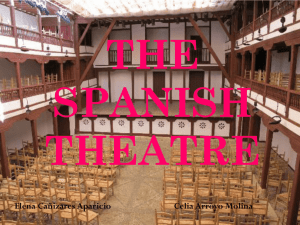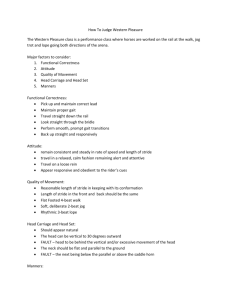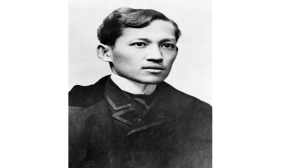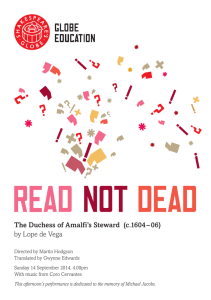ALICE CLEMENTE Fuenteovejuna, University Press, 2010). 106 pp. ISBN 978-0-300-16385-8.
advertisement
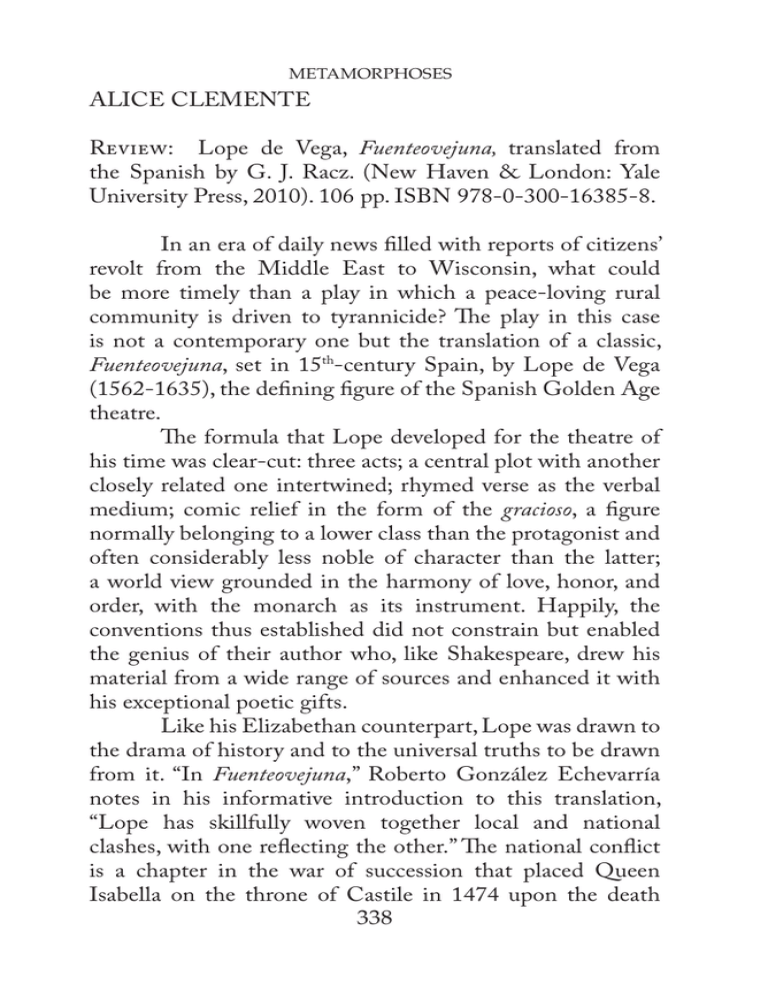
METAMORPHOSES ALICE CLEMENTE Review: Lope de Vega, Fuenteovejuna, translated from the Spanish by G. J. Racz. (New Haven & London: Yale University Press, 2010). 106 pp. ISBN 978-0-300-16385-8. In an era of daily news filled with reports of citizens’ revolt from the Middle East to Wisconsin, what could be more timely than a play in which a peace-loving rural community is driven to tyrannicide? The play in this case is not a contemporary one but the translation of a classic, Fuenteovejuna, set in 15th-century Spain, by Lope de Vega (1562-1635), the defining figure of the Spanish Golden Age theatre. The formula that Lope developed for the theatre of his time was clear-cut: three acts; a central plot with another closely related one intertwined; rhymed verse as the verbal medium; comic relief in the form of the gracioso, a figure normally belonging to a lower class than the protagonist and often considerably less noble of character than the latter; a world view grounded in the harmony of love, honor, and order, with the monarch as its instrument. Happily, the conventions thus established did not constrain but enabled the genius of their author who, like Shakespeare, drew his material from a wide range of sources and enhanced it with his exceptional poetic gifts. Like his Elizabethan counterpart, Lope was drawn to the drama of history and to the universal truths to be drawn from it. “In Fuenteovejuna,” Roberto González Echevarría notes in his informative introduction to this translation, “Lope has skillfully woven together local and national clashes, with one reflecting the other.” The national conflict is a chapter in the war of succession that placed Queen Isabella on the throne of Castile in 1474 upon the death 338 SPRING 2012 of her brother, Henry IV, at the expense of his (possibly illegitimate) daughter, Juana. The revolt in Fuenteovejuna took place two years later. The link between these two acts of rebellion is Fernán Gómez de Guzmán, Comendador of the military order of Calatrava, a supporter of Princess Juana and hence an enemy of the monarchs already occupying the throne by the time the play begins; he is also lord of the village of Fuenteovejuna. The Comendador is portrayed from the beginning as arrogant, disrespectful and viciously abusive, whether to the monarchs or to the villagers. In his own eyes, he is entitled to be so by virtue of his own lofty position – a self-image on which he expends a considerable amount of rhetoric. The author entwines these two areas of conflict and brings them both to resolution, restoring order through royal judgment when the forces of Calatrava are defeated by the followers of Ferdinand and Isabella, and the village of Fuenteovejuna is exonerated by the monarchs for its act of tyrannicide. In the process, the author also explores at length the defining theme of Spanish Golden Age theatre— honor—in all its ramifications and manifestations, social, philosophical and personal. The dramatic conflict of the play—and its philosophical resonance—is rooted not in the national revolt but in the Comendador’s rape of Fuenteovejuna, of its scarce resources, of the men he offends and abuses, of the women he quite literally violates before handing them over to his minions. The town fathers, dignified, wise and measured, attempt to reason with their master to no avail. The point of no return for the villagers is reached with the Comendador’s ultimate transgression, the profanation of the wedding of Laurencia and Frondoso. The Comendador bursts in on the festivities, arrests Frondoso and carries off his bride, leaving the stunned villagers to ponder their response. It is Laurencia (arguably one of the most magnificent female 339 METAMORPHOSES figures in all of Spanish literature) who, having resisted and escaped from her captor, provides the solution: collective action. In a village governed by reason and reflection, it is Laurencia’s explosive challenge to honor and valor that rules the day. A marvel of strength, virtue and passion, she vows, like the Amazons, to lead the women in fiery rebellion. Thus chastened, Fuenteovejuna avenges the many wrongs inflicted by the Comendador and recovers its honor. As they await the arrival of the judge who will inevitably investigate the event, the villagers make a pact; for the collective action, there will be collective responsibility. True to their oath, under torture men, women, children, all assert emphatically: Fuenteovejuna did it. They make their case before Ferdinand and Isabella and are exonerated. To create the “character” of the village and its moral underpinnings, Lope intersperses, throughout the action, debates, discussions and pronouncements by the thoughtful country folk on such topics as the nature of love and honor, and more limited and pointed ones such as the report by a university student home from Salamanca on Gutenberg’s new invention and its impact on writers and their texts—a subject dear to the heart of the author. The agility and sensitivity with which Lope moves from one register to another—historical narrative, lyrical passages, philosophy, humor—carries the complex action along at the same time that it seamlessly develops both individual and collective characters and probes the philosophical notions that sustain the play. As in all the Spanish comedia, rhymed verse is the artistic medium, with varied metric forms complementing the distinct theatrical moments. Romance (ballad form) is employed for narrative passages, the sonnet for lyrical introspection. Redondillas (quatrains), tercets, and the octava real are the mainstay for dialogue and in Fuenteovejuna in 340 SPRING 2012 particular, unlike much of Lopean theatre, the copla (couplet) is used for comic effect and for the display of the pueblo’s wit. G. J. Racz’s translation does justice to Lope’s masterpiece. With an impressive command of both Spanish and English, the translator works comfortably with all of the dramatic elements and with the varied metrical forms, challenged only by the romance, whose long stretches of assonantal rhyme, so natural in Spanish, are not sustainable in English. Even in these passages, though, Racz manages to transmit the tone, vigor and tenor of the original. Racz’s translation is a masterful rendering of one of Spain’s most universal classics. 341
